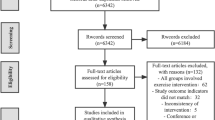Abstract
Purpose
Atypical parkinsonism (AP) has a considerable impact on the lives not only of patients but also of their carers. The aim of this study was to develop an instrument for assessing the quality of life (QoL) of carers of patients with AP.
Methods
A 40-item pool was generated from in-depth interviews with carers of patients with AP, a thorough review of the existing literature and consultation with movement disorder experts. Item refinement and reduction was performed using the results of pilot testing and a survey in 282 carers of multiple system atrophy (MSA) patients and 226 carers of progressive supranuclear palsy (PSP) patients. A validation study, with responses of 243 carers of MSA and 187 carers of PSP patients, was undertaken to evaluate the psychometric properties of the final 26-item scale.
Results
The validation study results suggest that the scale is unidimensional and has high internal consistency (Cronbach’s α = 0.96). The correlations of scale scores with patients’ health status and QoL measures, such as PDQ-39 summary score and EQ-5D index (Spearman’s ρ = 0.56 and −0.31, respectively, P < 0.001), as well as carers’ measures, such as Caregiver Burden Inventory (CBI) total and EQ-5D index (Spearman’s ρ = 0.85 and −0.39, respectively, P < 0.001), document the convergent and concurrent validity of the scale. ANOVA results support the discriminant validity of the scale, as evidenced by its capacity to differentiate between carers with varying levels of self-reported health.
Conclusions
The 26-item Parkinsonism Carers QoL (PQoL Carer) is a concise instrument with adequate psychometric qualities that can be used for clinical and research purposes.
Similar content being viewed by others
References
Schrag, A., Geser, F., Stampfer-Kountchev, M., et al. (2006). Health-related quality of life in Multiple Systems Atrophy. Movement Disorders, 22, 809–815.
Schrag, A., Ben-Shlomo, Y., & Quinn, N. P. (1999). Prevalence of progressive supranuclear palsy and multiple system atrophy: A cross-sectional study. Lancet, 354, 1771–1775.
Schrag, A., Selai, C., Mathias, C., et al. (2007). Measuring health-related quality of life in MSA: The MSA-QoL. Movement Disorders, 22, 2332–2338.
Schrag, A., Selai, C., Quinn, N., et al. (2006). Measuring quality of life in PSP. Neurology, 67, 39–44.
Jenkinson, C., Dummett, S., Kelly, L., et al. (2012). The development and validation of a quality of life measure for the carers of people with Parkinson’s disease (the PDQ-Carer). Parkinsonism and Related Disorders, 18, 483–487.
The EuroQol Group. (1990). EuroQol-a new facility for the measurement of health-related quality of life. Health Policy, 16, 199–208.
Zigmond, A. S., & Snaith, R. P. (1983). The Hospital Anxiety and Depression Scale. Acta Psychiatrica Scandinavica, 67, 361–370.
Novak, M., & Guest, C. I. (1989). Application of a multidimensional care-giver burden inventory. Gerontologist, 29, 798–803.
Peto, V., Jenkinson, C., & Fitzpatrick, R. (1998). PDQ-39: A review of the development, validation and application of a Parkinson’s disease quality of life questionnaire and its associated measures. Journal of Neurology, 245(suppl 1), S10–S14.
Kaiser, H. F. (1970). A second generation little jiffy. Psychometrica, 35, 401–416.
Dziuban, C., & Shirkey, E. (1974). When is a correlation matrix appropriate for factor analysis? Some decision rules. Psychological Bulletin, 81, 358–361.
Horn, J. L. (1965). A rationale and test for the number of factors in factor analysis. Psychometrica, 30, 179–185.
O’Connor, B. P. (2000). SPSS and SAS programs for determining the number of components using parallel analysis and Velicer’s MAP test. Behavior Research Methods, Instrumentation, and Computers, 32, 396–402.
Choi, N., Fuqua, D. R., & Griffin, B. W. (2001). Exploratory analysis of the structure of scores from the multidimensional scales of perceived self-efficacy. Educational and Psychological Measurement, 61, 475–489.
Costello, A. B., Osborne, J. (2005). Best practices in exploratory factor analysis: Four recommendations for getting the most from your analysis. Practical Assessment Research and Evaluation, 10. http://pareonline.net/getvn.asp?v=10&n=7. Accessed December 15, 2014.
Hayton, J. C., Allen, D. G., & Scarpello, V. (2004). Factor retention decisions in exploratory factor analysis: A tutorial on parallel analysis. Organizational Research Methods, 7, 191–205.
Acknowledgments
This work was supported by Society for Progressive Supranuclear Palsy, Sarah Matheson Trust for Multiple System Atrophy (UK), and The Progressive Supranuclear Palsy (PSP Europe) Association. We thank all the patients who participated and the patient organizations that supported this project.
Author information
Authors and Affiliations
Corresponding author
Rights and permissions
About this article
Cite this article
Pillas, M., Selai, C., Quinn, N.P. et al. Development and validation of a carers quality-of-life questionnaire for parkinsonism (PQoL Carers). Qual Life Res 25, 81–88 (2016). https://doi.org/10.1007/s11136-015-1071-y
Accepted:
Published:
Issue Date:
DOI: https://doi.org/10.1007/s11136-015-1071-y




